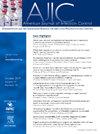Impact of empowerment of onco-hematological patients on the incidence of catheter-related bloodstream infections
IF 2.4
3区 医学
Q2 INFECTIOUS DISEASES
引用次数: 0
Abstract
Background
Patients with hematologic malignancies and hematopoietic stem cell transplant recipients (HSCT) are at high risk of central venous catheter-related bloodstream infections (CLABSI). Global actions have encouraged patient empowerment as a strategy to reduce these infections. We aim to evaluate the impact of patient empowerment in reducing the incidence density (ID) of CLABSI.
Methods
Prospective, pre- and post-intervention, quantitative study of development, validation and application of an instrument to assess good practices in CVC handling, consisting of 6 questions and answers by hospitalized patients who had a CVC in 2 oncological units.
Results
Fifty-three patients were enrolled, totaling 1,290 evaluations. In the postintervention period, a significant increase (P < .001) was observed in 3 practices: hand hygiene after handling the CVC (92.1% vs 98.8%), salinization with pulsatile movements after administering medications and collecting laboratory tests (86.8% vs 96.7%) and daily CVC assessment (97.4% vs 99.8%). The ID of CLABSI decreased in the HSCT unit (4.4 vs 0 CLABSI/1,000 CVC-days), though without statistical significance (P = .066).
Discussion
Increased adherence to good practices highlights the potential of patient involvement as a complementary strategy for CLABSI prevention.
Conclusions
Actions aimed at patient participation can contribute to improving processes and reducing the ID of CLABSI.
肿瘤血液学患者赋权对导管相关血流感染发生率的影响。
背景:恶性血液病和造血干细胞移植(HSCT)患者发生中心静脉导管相关血流感染(CLABSI)的风险较高。全球行动鼓励对患者进行培训和增强权能,以此作为减少这些感染的一项战略。目的:评价患者赋权对降低CLABSI发生率密度(ID)的影响。方法:对一种评估CVC处理良好做法的工具的开发、验证和应用进行前瞻性、干预前后、定量研究,该工具由一家肿瘤医院两个单位的CVC住院患者的六个问题和答案组成。结果:53例患者参与研究,共计1290次评估。在干预后时期,显著增加(讨论:加强对良好做法的坚持,突出了患者参与作为预防CLABSI的补充策略的潜力。结论:旨在患者参与的行动有助于改善过程和减少CLABSI的ID。
本文章由计算机程序翻译,如有差异,请以英文原文为准。
求助全文
约1分钟内获得全文
求助全文
来源期刊
CiteScore
7.40
自引率
4.10%
发文量
479
审稿时长
24 days
期刊介绍:
AJIC covers key topics and issues in infection control and epidemiology. Infection control professionals, including physicians, nurses, and epidemiologists, rely on AJIC for peer-reviewed articles covering clinical topics as well as original research. As the official publication of the Association for Professionals in Infection Control and Epidemiology (APIC)

 求助内容:
求助内容: 应助结果提醒方式:
应助结果提醒方式:


